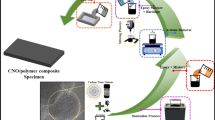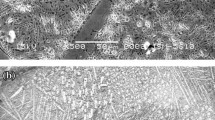Abstract
Polyurethane is used for making mould in soft tooling (ST) process for producing wax/plastic components. These wax components are later used as pattern in investment casting process. Due to low thermal conductivity of polyurethane, cooling time in ST process is long. To reduce the cooling time, thermal conductive fillers are incorporated into polyurethane to make composite mould material. However, addition of fillers affects various properties of the ST process, such as stiffness of the mould box, rendering flow-ability of melt mould material, etc. In the present work, multi-objective optimization of various conflicting objectives (namely maximization of equivalent thermal conductivity, minimization of effective modulus of elasticity, and minimization of equivalent viscosity) of composite material are conducted using evolutionary algorithms (EAs) in order to design particle-reinforced polyurethane composites by finding the optimal values of design parameters. The design parameters include volume fraction of filler content, size and shape factor of filler particle, etc. The Pareto-optimal front is targeted by solving the corresponding multi-objective problem using the NSGA-II procedure. Then, suitable multi-criterion decision-making techniques are employed to select one or a small set of the optimal solution(s) of design parameter(s) based on the higher level information of the ST process for industrial applications. Finally, the experimental study with a typical real industrial application demonstrates that the obtained optimal design parameters significantly reduce the cooling time in soft tooling process keeping other processing advantages.













Similar content being viewed by others
Abbreviations
- L:
-
Low
- M:
-
Medium
- H:
-
High
- φ m :
-
Maximum packing fraction of disperse phase
- η r :
-
Relative viscosity of suspension
- η p :
-
Viscosity of melt polymer/matrix (Pa s)
- η c :
-
Equivalent viscosity of melt composite (Pa s)
- k c :
-
Equivalent thermal conductivity of composite (w/m k)
- k p :
-
Thermal conductivities of polymer/matrix (w/m k)
- k f :
-
Thermal conductivities of filler material (w/m k)
- V f :
-
Volumetric fraction of filler in the composite (%)
- E c :
-
Equivalent modulus of elasticity of composite (N/mm2)
- K c :
-
Equivalent bulk modulus of composite (N/mm2)
- G c :
-
Equivalent shear modulus of composite (N/mm2)
- G m :
-
Shear modulus of matrix/polymer (N/mm2)
- G f :
-
Shear modulus of filler material (N/mm2)
- G c :
-
Shear modulus of composite (N/mm2)
- K m :
-
Bulk modulus of matrix/polymer (N/mm2)
- K f :
-
Bulk modulus of filler material (N/mm2)
- P s :
-
Filler particle size (µm)
- S f :
-
Shape factor
- T :
-
Temperature (°C)
References
Agari Y, Uno T (1986) Estimation on thermal conductivities of filled polymers. J Appl Polym Sci 32(7):5705–5712
Agrawal R, Saxena NS, Mathew G, Thomas S, Sharma KB (2000) Effective thermal conductivity of three-phase styrene butadiene composites. J Appl Polym Sci 76:1799–1803
Boudenne A, Ibos L, Fois M, Gehin E, Majeste JC (2004) Thermophysical properties of polypropylene/aluminium composites. J Polym Sci Part B: Polym Phys 42(4):722–732
Branke J, Deb K, Dierolf H, Osswald M (2004) Finding knees in multi-objective optimization. In: Yao X et al (eds) PPSN 2004. LNCS, Springer, Heidelberg, 3242:722–731
Deb K (2001) Multiobjective optimization using evolutionary algorithms. Wiley, Chichester
Deb K, Srinivasan A (2006) Innovization: innovating design principles through optimization. In: Proceedings of the genetic and evolutionary computation conference (GECCO-2006), The Association of Computing Machinery (ACM), New York, pp 1629–1636
Deb K, Pratap A, Agarwal S, Meyarivan T (2002) A fast elitist non-dominated sorting genetic algorithm for multi-objective optimisation: NSGA-II. IEEE Trans Evol Comput 6(2):182–197
Goldberg DE (2002) Genetic algorithms in search optimization and machine learning. Pearson-Education, New Delhi
Hashin Z, Shtrikman S (1963) A variational approach to the theory of the elastic behaviour of multiphase materials. J Mech Phys Solids 11:127–140
Iqbal A, Frormann L, Saleem A, Ishaq M (2007) The effect of filler concentration on the electrical, thermal, and mechanical properties of carbon fiber-reinforced poly(styrene-co-acrylonitrile) composites. Polym Compos 28(2):186–197
Ishida H, Rimdusit S (1998) Very high thermal conductivity obtained by boron nitride-filled polybenzoxazine. Thermochim Acta 320:177–186
Keith JM, King JA, Lenhart KM, Zimny B (2007) Thermal conductivity models for carbon/liquid crystal polymer composites. J Appl Polym Sci 105(6):3309–3316
Kim SW, Choi B, Lee SH, Kang KH (2008) Measurement of thermophysical properties of particulate-filled polymer composites. High Temperatures-High Pressures 37(1):21–30
Krieger IM, Dougherty TJ (1959) A mechanism for non-newtonian flow in suspensions of rigid spheres. Trans Soc Rheol III:137–152
Lewis TB, Nielsen LE (1970) Dynamic mechanical properties of particulate-filled composites. J Appl Polym Sci 14(6):1449–1471
Lielens G, Pirotte P, Couniot A, Dupret F, Keunings R (1998) Prediction of thermo-mechanical properties for compression moulded composites. Composites Part A: Appl Sci Manuf 29(1–2):63–70
Lopes CMA, Felisberti MI (2004) Thermal conductivity of PET/(LDPE/Al) composites determined by MDSC. Polym Testing 23(6):637–643
Mamunya YP, Davydenko VV, Pissis P, Lebedev EV (2002) Electrical and thermal conductivity of polymers filled with metal powders. Eur Polym J 38:1887–1897
Miettinen K (1999) Nonlinear multiobjective optimization, Kluwer, Boston
Miller MG, Keith JM, King JA, Edwards BJ, Klinkenberg N, Schiraldi DA (2006) Measuring thermal conductivities of anisotropic synthetic graphite-liquid crystal polymer composites. Polym Compos 27(4):388–394
Mu Q, Feng S, Diao G (2007) Thermal conductivity of silicone rubber filled with ZnO. Polym Compos 28(2):125–130
Nandi AK (2006) TSK-Type FLC using a combined LR and GA: surface roughness prediction in ultraprecision turning. J Mater Process Technol 178(1–3):200–210
Nandi AK, Vesterinen A, Cingi C, Seppala J, Orkas J (2010a) Studies on equivalent viscosity of particle-reinforced flexible mold materials used in soft tooling process. J Reinf Plast Composites 29(14):2081–2098
Nandi AK, Datta S, Deb K, Orkas J (2010b) Studies on effective thermal conductivity of particle reinforced polymeric flexible mould material composites: a genetic fuzzy based approach. In: Proceedings (in CD) of the 3rd international conference on recent advances in composite materials (ICRACM2010), Limoges, France, 13–15 December, 2010, pp 1–6
Nandi AK, Datta S, Orkus J (2011a) Effective properties of particle reinforced flexible mould material towards reducing cooling time in soft tooling process. J Appl Polym Sci. doi:10.1002/app.34654
Nandi AK, Datta S, Deb K (2011b) Investigating the role of non-metallic fillers in particulate reinforced flexible mould material composites using evolutionary algorithms. Mater Manuf Process 26(3):541–549
Nandi AK, Deb K, Ganguly S, Datta S (2011c) Investigating the role of metallic fillers in particulate reinforced flexible mould material composites using evolutionary algorithms. Appl Soft Comput. doi:10.1016/j.asoc.2011.08.059
Ng HY, Lu X, Lau SK (2005) Thermal conductivity of boron nitride-filled thermoplastics: effect of filler characteristics and composites processing conditions. Polym Compos 26(6):778–790
Oliveira FA, Alves N, Giacometti JA, Constantino CJL, Mattoso LHC, Balan AMOA, Job AE (2007) Study of the thermomechanical and electrical properties of conducting composites containing natural rubber and carbon black. J Appl Polym Sci 106(2):1001–1006
Ouchiyama N, Tanaka T (1984) Porosity estimation for random packings of spherical particles. Ind Eng Chem Fundam 23:490–493
Razzaq MY, Frormann L (2007) Thermomechanical studies of aluminium nitride filled shape memory polymer composites. Polym Compos 28(3):287–293
Rosochowski A, Matuszak A (2000) Rapid tooling: the state of the art. J Mater Process Technol 106(1–3):191–198
Siegel S (1956) Non-parametric statistics for the behavioral sciences. McGraw-Hill, New York, pp 75–83
Subodh G, Manjusha MV, Philip J, Sebastian MT (2008) Thermal properties of polytetrafluoroethylene/Sr2Ce2Ti5O16 polymer/ceramic composites. J Appl Polym Sci 108(3):1716–1721
Sundstrom DW, Chen SY (1970) Thermal conductivity of reinforced plastics. Journal of Compos Mater 4(1):113–117
Tsukuda R, Sumimoto S, Ozawa T (1997) Thermal conductivity and heat capacity of ABS resin composites. J Appl Polym Sci 63(10):1279–1286
Veldhuizen DV, Lamont GB (2000) Multiobjective evolutionary algorithms: analyzing the state-of-the-art. Evol Comput J 8(2):125–128
Vinod VS, Varghese S, Kuriakose B (2004) Aluminium powder filled nitrile rubber composites. J Appl Polym Sci 91(5):3156–3161
Wang Q, Gao J, Wang R, Hua Z (2001) Mechanical and rheological properties of HDPE/graphite composite with enhanced thermal conductivity. Polym Compos 22(1):97–103
Wang L, Li F, Su Z (2008) Effective thermal conductivity behaviour of filled vulcanized perfluoromethyl vinyl ether rubber. J Appl Polym Sci 108(5):2968–2974
Weidenfeller B, Hofer M, Schilling FR (2004) Thermal conductivity, thermal diffusivity, and specific heat capacity of particle filled polypropylene. Compos Part A: Appl Sci Manuf 35(4):423–429
Wong CP, Bollampally RS (1999) Thermal conductivity, elastic modulus, and coefficient of thermal expansion of polymer composites filled with ceramic particles for electronic packaging. J Appl Polym Sci 74(14):3396–3403
Xu Y, Chung DDL, Mroz C (2001) Thermally conducting aluminium nitride polymer-matrix composites. Compos Part A: Appl Sci Manuf 32(12):1749–1757
Yu PL (1973) A class of solutions for group decision problems. Manage Sci 19(8):936–946
Yu S, Hing P, Hu X (2002) Thermal conductivity of polystyrene-aluminium nitride composite. Compos Part A: Appl Sci Manuf 33(2):289–292
Zitzler E, Thiele L (1998) An evolutionary algorithm for multiobjective optimization: the strength Pareto approach. Technical Report 43, Zürich, Switzerland: Computer Engineering and Networks Laboratory (TIK), Swiss Federal Institute of Technology (ETH)
Acknowledgments
The authors are thankful to DST (Department of Science and Technology), New Delhi, India, for supporting this research work under the BOYSCAST fellowship programme. Prof. K. Deb also acknowledges the Finland Distinguished Professor (FioDiPro) award by the Academy of Finland.
Author information
Authors and Affiliations
Corresponding author
Rights and permissions
About this article
Cite this article
Nandi, A.K., Datta, S. & Deb, K. Design of particle-reinforced polyurethane mould materials for soft tooling process using evolutionary multi-objective optimization algorithms. Soft Comput 16, 989–1008 (2012). https://doi.org/10.1007/s00500-011-0797-x
Published:
Issue Date:
DOI: https://doi.org/10.1007/s00500-011-0797-x




